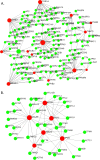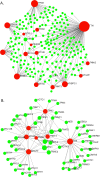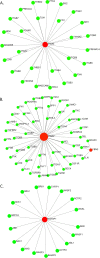TTN as a candidate gene for distal arthrogryposis type 10 pathogenesis
- PMID: 35951140
- PMCID: PMC9372250
- DOI: 10.1186/s43141-022-00405-5
TTN as a candidate gene for distal arthrogryposis type 10 pathogenesis
Abstract
Background: Arthrogryposis is a medical term used to describe congenital contractures which often affect multiple limbs. Distal arthrogryposis (DA) is one of the major categories of arthrogryposis that primarily affects the distal parts of the body, i.e., the hands and the legs. Although ten different types and several subtypes of DAs have been described, the genes associated with each of these DAs are yet to be characterized. Distal arthrogryposis type 10 (DA10) is a rare genetic disease, which is distinguished from the other arthrogryposis types by plantar flexion contractures resulting in toe-walking during infancy as well as variability in contractures of the hip, hamstring, elbow, wrist and finger joints with no ocular or neurological abnormalities. Symptoms of DA10 indicate impairment specifically in the musculoskeletal system. DA10 is still poorly studied.
Aim: The objective of this study was to identify the candidate gene for DA10 by scrutinizing the protein-protein interaction (PPI) networks using in silico tools.
Results: Among the genes that reside within the previously reported genomic coordinates (human chromosome assembly 38 or GRCh38 coordinates 2:179,700,000-188,500,000) of the causative agent of DA10, only TTN (the gene that codes for the protein Titin or TTN) follows the expression pattern similar to the other known DA associated genes and its expression is predominant in the skeletal and heart muscles. Titin also participates in biological pathways and processes relevant to arthrogryposes. TTN-related known skeletal muscle disorders follow the autosomal-dominant pattern of inheritance, which is a common characteristic of distal arthrogryposes as well.
Conclusion: Based on the findings of the analyses and their correlation with previous reports, TTN appears to be the candidate gene for DA10. Our attempt to discover a potential candidate gene may eventually lead to an understanding of disease mechanism and possible treatment strategies, as well as demonstrate the suitability of PPI in the search for candidate genes.
Keywords: Congenital contractures; Distal arthrogryposis; Protein-protein interaction network; TTN; Titin.
© 2022. The Author(s).
Conflict of interest statement
The authors declare that they have no competing interests.
Figures




References
-
- Dahan-Oliel N, Cachecho S, Barnes D, Bedard T, Davison AM, Dieterich K, Donohoe M, et al. International multidisciplinary collaboration toward an annotated definition of arthrogryposis multiplex congenita. American journal of medical genetics. Part C Sem Med Genet. 2019;181:288–299. doi: 10.1002/ajmg.c.31721. - DOI - PMC - PubMed
-
- Xue S, Maluenda J, Marguet F, Shboul M, Quevarec L, Bonnard C, Ng AY, et al. Loss-of-function mutations in LGI4, a secreted ligand involved in schwann cell myelination, are responsible for Arthrogryposis Multiplex Congenita. Am J Human Genet. 2017;100:659–665. doi: 10.1016/j.ajhg.2017.02.006. - DOI - PMC - PubMed
LinkOut - more resources
Full Text Sources
